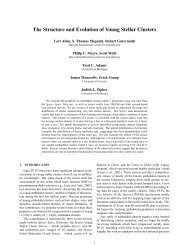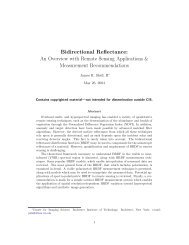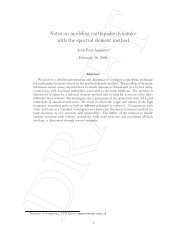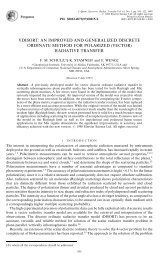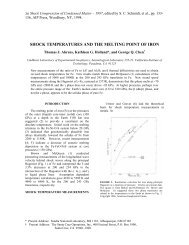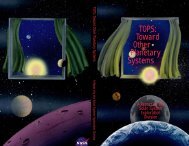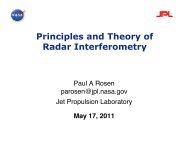6.4. SLEAVE SupplementHere, the surface-leaving (SL) supplement is described. The SL supplement is a separate systemof <strong>VLIDORT</strong>-based software that provides an additional source of upwelling radiance at thelower boundary of the atmosphere. One familiar example is the "water-leaving" radiance over anocean boundary; another is the near infra-red (NIR) fluorescence signature from vegetation. ThisSL term is a diffuse upwelling radiance from the lower boundary, on top of the existing diffuseanddirect-beam reflected light. This is the first version of the SL supplement, and is currentlyconfigured for simple treatments of water-leaving radiance and NIR fluorescence. We note thatthe supplement also has the observational geometry facility like <strong>VLIDORT</strong> itself.In section 6.4.1, we give an overview of SL construction and discuss the available options. Thisis followed by a description of the supplement’s current development state in section 6.4.2. Next,a sample calling sequence for the supplement is given in section 6.4.3. The supplement inputsand outputs are then given in tables in section 6.4.4; in particular, we wish to fill up the SL inputsin Tables C4 and G4 in sections 6.1.1.3 and 6.1.1.7, respectively.6.4.1. SLEAVE formulationThe SL contribution output from the supplement consists of 3 terms which will in general dependon the solar illumination angle θ oand the relative azimuth angle ϕ − ϕo(think of the waterleavingradiance). These terms are (we have omitted the Stokes-component index for clarity):S ( μ , θ ); S ( γ, θ ); S ( γ, θ , ϕ− ϕ ) . (6.4.1)m i o m o exact o oHere, the Fourier component index m= 0,1,...,2N− 1, where N is the number of discreteordinates in the half-space. The first term is the (Fourier component of) upwelling radiance intothe polar discrete ordinate directions μ i, and this is required for the diffuse-scattering boundarycondition at the lower surface. The second term is the (Fourier component of) upwelling radianceinto user-defined stream directions γ, and this is required for post-processing of the discreteordinate solution (source function integration).The first two terms arise from the Fourier cosine-azimuth expansions of the full functionsS ( μ , θ , ϕ− ϕ ) and S ( γ , θ , ϕ− ϕ ) ; thus for example:exact i o oexact o oS ( μ , θ , ϕ− ϕ ) = S ( μ , θ ) + 2 ∑ S ( μ , θ )cos( ϕ−ϕ)(6.4.2)exact i o o o i o m i o om=1∞In the discrete-ordinate approximation we can only use 2N-1 components in the sum in Eq.(6.4.2). In the post-processing, it is more accurate to use the complete term Sexact ( γ , θo, ϕ− ϕo)inplace of the Fourier-series truncation, and this "correction" is implemented. This is akin to makea precise calculation of the direct-beam surface reflection, and indeed the "direct" surface termwill now include Sexact ( γ , θo, ϕ− ϕo) if desired. In this case, the Fourier terms Sm( γ , θo)are notneeded.116
We will also consider the simpler situation where the SL contribution consists of an isotropicterm S * ( θo) which depends only on the incoming solar direction (no azimuth dependence, all*outgoing directions equal). In this case, Sm( μ, θo) = 0 ( m≥ 1) and So( μ, θo) = S ( θo)for all*outgoing polar directions μ, and also S ( γ , θ , ϕ− ϕ ) = S ( θ ).exact o o oLinearization. We assume that there is no effect of the atmosphere on the magnitudes of thesurface-leaving terms - they depend solely on intrinsic quantities. We will therefore require thesupplement to define partial derivatives of the SL terms in Eq. (6.4.1) with respect to somesurface property ξ (which might be the wind speed or the fluorescence at 755 nm):∂Sexact ∂Sm ∂Sm( γ , θo, ϕ−ϕo); ( μi, θo); ( γ, θo). (6.4.3)∂ξ ∂ξ ∂ξThe linearized SL supplement will generate these derivatives, which <strong>VLIDORT</strong> is then able toingest, thereby making it possible to generate <strong>VLIDORT</strong> Jacobian output with respect to surfaceproperty ξ.6.4.2. Current developmentAt the present time, there are two simple models for isotropic surface leaving contributionsS * ( θ ) o(water-leaving and NIR fluorescence). These are described below.Water-leaving. The isotropic water-leaving term is computed from a straightforward ocean-colorresult based only on the chlorophyll absorption loading c a . The code is based on a modeldeveloped at NASA-GSFC for water-leaving radiance computation. A more sophisticated modelis currently under construction - this will be based on specular reflection and transmittancethrough an air/ocean interface, with dependency on the wind speed W and relative refractiveindex n water , as well as the chlorophyll coefficient c a , and other marine properties such as CDOM(dissolved organic matter).Fluorescence. This is based on the double-Gaussian model in [Frankenburg et al., 2012], whichhas now been used in a number of studies on the fluorescence signature. We would like to thankChris O'Dell for allowing us to use this model. The calculation is simple:2 2* ( λ−λ1) ( λ−λ2)S ( θb) = F( λ, θb) = F755( θb){ A1 exp[ − ] + A2 2exp[ − ]}(6.4.4)2σσ1 2The wavelengths λ 1 and λ 2 correspond to peaks at 683 nm and 730 nm respectively, and all theGaussian constants are tabulated in the aforementioned reference. The fluorescence at 755 nm isbased on a huge multi-year data set derived from satellite observations, and it depends on thesolar angle, the 'epoch' (year, month, day, hour, etc.) and the latitude and longitude coordinates.It follows that the SL supplement input required for use with <strong>VLIDORT</strong> will require thefollowing inputs: the wavelength λ, a series of solar zenith angles θ o , and time and geographicalvariables. Equation (6.4.4) is easy to differentiate with respect to the defining parameters. Themain interest here is generation of <strong>VLIDORT</strong> Jacobians for the parameterξ( )q= F755 θo, for∂S which* ( θo)is trivial. This option is controlled by a separate Boolean flag. Technically it∂ξq117
- Page 1:
User’s GuideVLIDORTVersion 2.6Rob
- Page 5 and 6:
Table of Contents1H1. Introduction
- Page 7 and 8:
1. Introduction to VLIDORT1.1. Hist
- Page 9 and 10:
Table 1.1 Major features of LIDORT
- Page 11 and 12:
In 2006, R. Spurr was invited to co
- Page 13:
corrections, and sphericity correct
- Page 16 and 17:
Matrix Π relates scattering and in
- Page 18 and 19:
m⎛ P⎞l( μ)0 0 0⎜⎟mmm ⎜ 0
- Page 20 and 21:
In the following sections, we suppr
- Page 22 and 23:
of the single scatter albedo ω and
- Page 24 and 25:
Here T n−1 is the solar beam tran
- Page 26 and 27:
~ + ~ ~ (1)~ ~ + ~ ~ (2)~ ~ − ~ 1
- Page 28 and 29:
The solution proceeds first by the
- Page 30 and 31:
Linearizations. Derivatives of all
- Page 32 and 33:
For the plane-parallel case, we hav
- Page 34 and 35:
One of the features of the above ou
- Page 36 and 37:
L↑↑ ↑k (cot n −cotn −1)[
- Page 38 and 39:
Note the use of the profile-column
- Page 40 and 41:
βl,aer(1)(2)fz1e1βl+ ( 1−f ) z2
- Page 42 and 43:
For BRDF input, it is necessary for
- Page 44 and 45:
streams were used in the half space
- Page 46 and 47:
anded tri-diagonal matrix A contain
- Page 48 and 49:
in place to aid with the LU-decompo
- Page 50 and 51:
In earlier versions of LIDORT and V
- Page 53 and 54:
4. The VLIDORT 2.6 package4.1. Over
- Page 55 and 56:
(discrete ordinates), so that dimen
- Page 57 and 58:
Table 4.2 Summary of VLIDORT I/O Ty
- Page 59 and 60:
Table 4.3. Module files in VLIDORT
- Page 61 and 62:
Finally, modules vlidort_ls_correct
- Page 63 and 64:
end program main_VLIDORT4.3.2. Conf
- Page 65 and 66: $(VLID_DEF_PATH)/vlidort_sup_brdf_d
- Page 67 and 68: Finally, the command to build the d
- Page 69 and 70: Here, “s” indicates you want to
- Page 71 and 72: The main difference between “vlid
- Page 73 and 74: to both VLIDORT and the given VSLEA
- Page 75 and 76: STATUS_INPUTREAD is equal to 4 (VLI
- Page 77 and 78: 5. ReferencesAnderson, E., Z. Bai,
- Page 79 and 80: Mishchenko, M.I., and L.D. Travis,
- Page 81: Stamnes K., S-C. Tsay, W. Wiscombe,
- Page 84 and 85: Table A2: Type Structure VLIDORT_Fi
- Page 86 and 87: DO_WRITE_FOURIER Logical (I) Flag f
- Page 88 and 89: USER_LEVELS (o) Real*8 (IO) Array o
- Page 90 and 91: angle s, Stokes parameter S, and di
- Page 92 and 93: DO_SLEAVE_WFS Logical (IO) Flag for
- Page 94 and 95: 6.1.1.8. VLIDORT linearized outputs
- Page 96 and 97: NFINELAYERS Integer Number of fine
- Page 98 and 99: 6.1.2.4. VLIDORT linearized modifie
- Page 100 and 101: The output file contains (for all 3
- Page 102 and 103: The first call is the baseline calc
- Page 104 and 105: for a 2-parameter Gamma-function si
- Page 106 and 107: Remark. In VLIDORT, the BRDF is a 4
- Page 108 and 109: 6.3.3.1. Input and output type stru
- Page 110 and 111: Table C: Type Structure VBRDF_LinSu
- Page 112 and 113: Special note regarding Cox-Munk typ
- Page 114 and 115: squared parameter, so that Jacobian
- Page 118 and 119: is possible to define Jacobians wit
- Page 120 and 121: etween 0 and 90 degrees.N_USER_OBSG
- Page 122: 6.4.4.2 SLEAVE configuration file c



